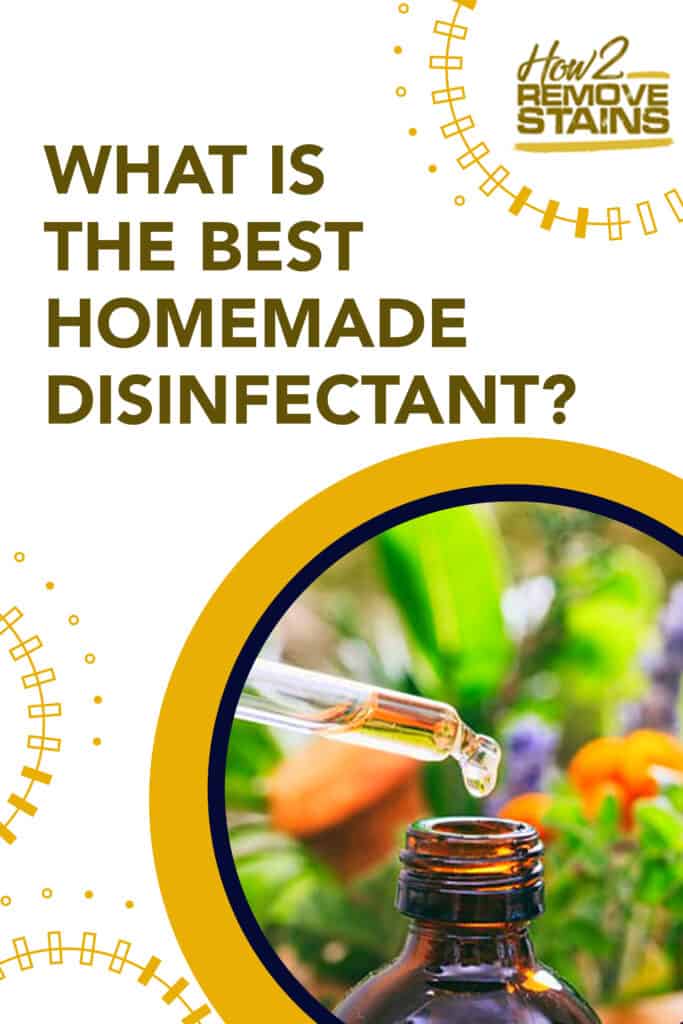The best homemade disinfectant is a mixture of 12 oz 70% alcohol, 3.5 oz. water, ½ teaspoon hydrogen peroxide, and 40 drops of germ-killing essential oils (lavender, lemon, rosemary, eucalyptus, tea tree, peppermint). To apply, clean the surface, spray the mixture, and leave it to dry.
Store-bought disinfectants are becoming less preferable because of the toxins they contain. These products are chemically concentrated, and they can potentially do more harm than good. Luckily, you can easily make effective homemade disinfectants using safer and more natural ingredients.
Below are some easy ways to make a natural disinfectant at home using ingredients like alcohol, hydrogen peroxide, vinegar, bleach and essential oils.
Table of Contents
An alcohol and hydrogen peroxide disinfectant
The combination of alcohol and hydrogen peroxide are effective at killing both viruses and bacteria.
The ingredients
- 12 ounces of alcohol with 70% solution (this percentage is recommended by the CDC)
- 3.5 ounces of distilled drinking water
- Half a teaspoon of hydrogen peroxide
- 40 drops of essential oils
The procedure
- Get a clean 16-ounce spray bottle and pour in the alcohol and distilled water.
- Mix in the hydrogen peroxide.
- Add 40 drops of essential oil.
- Shake the bottle to mix the ingredients well.
- Label the spray bottle.
Application
To use this disinfectant, follow these steps:
- Clean the surface to be disinfected. Use a cloth and clean water (or soapy water if you need to remove some stains or built-up dirt).
- Dry the surface with a clean cloth.
- Shake the bottle (do this every time before you use the disinfectant).
- You can use a cloth or spray directly on the surface, whether it’s on faucets, countertops, or other common points of contact such as doorknobs, stair handrails, remote controls, etc.
- If you spray directly, make sure it’s enough to keep the surface wet for 3 minutes or longer.
- Leave the disinfectant to dry.
Using it as a deodorizer
Another application for this disinfectant is to deodorize clothes, shoes and sporting equipment. You just need to:
- Shake the spray bottle and spray directly on the fabric until it becomes damp but not dripping wet. It should stay this way for at least 30 seconds. However, if you’re spraying on shoes and sporting equipment, allow the disinfectant to soak in and dry overnight.
- Leave the fabric to dry.
- Repeat the steps until the odor disappears.
Types of alcohol you can use to make this mixture:
- Ethanol alcohol- You can use drinkable grain alcohol if the solution is at least 70% or 140 proof. Everclear, a 190-proof alcohol with 92.4% solution, is a good choice. If this seems too concentrated for you, dilute the mixture by adding more water.
- Isopropyl alcohol- This is also known as rubbing alcohol. You should choose one with a 70% to 99% solution.
Essential oil options
There are plenty of essential oils with disinfecting, antifungal, antimicrobial, antibacterial, antiviral, and antiseptic properties, including:
- Lavender
- Lemon
- Rosemary
- Eucalyptus
- Tea tree
- Peppermint
Each of these oils have disinfecting properties, so they’ll benefit your disinfecting solution. For instance, lavender is antiviral, antiseptic, antibacterial, and antifungal. Read hear to learn more about essential oils’ germ fighting capabilities.
Instead of just using one type of essential oil, you can combine them together. Here’s the combination we suggest and the number of drops for each: 30 drops of tea tree oil, 15 drops of lavender oil and 15 drops of lemon oil.
A diluted beach solution
Bleach solutions at high concentrations work effectively and quickly to kill pathogens. On the other hand, weaker solutions may not be as effective and require more contact time. Nonetheless, these solutions are a great option if you want less skin irritation and surface damage.
Ingredients:
- Bleach
- Water
- Spray bottle
Procedure:
Make the solution depending on how strong or diluted you want your solution to be. For a strong solution of 1:10 ratio, mix 1 ½ cups of beach per gallon of water. Mix ½ cups of bleach per gallon of water for a medium solution (1:32 ratio) and 1/3 cups of bleach per gallon water for a diluted solution.
A vinegar spray
If you are not able to make a bleach disinfectant, a vinegar disinfectant is a good option. You can use it on floors, sinks, windows, glass, cupboards, walls, coffee makers, stovetops and other surfaces with lower contamination risk.
It is important to note the vinegar disinfectant is not as effective in eliminating some bacteria and viruses like COVID -19. Also, it is advisable to use a glass bottle if you choose to add essential oils as they sometimes react with plastic.
Ingredients:
- Vinegar (at least 5%)
- Distilled water
- Essential oil
Procedure:
- Mix vinegar and water in a ratio of 1:1.
- Add 5 to 15 drops of your preferred essential oil
- The sitting time for this disinfectant is 30 minutes
Vinegar and baking soda spray
This is another vinegar-based disinfectant that works on surfaces with a low risk infection.
Ingredients:
- ¼ cup of white vinegar
- 2 tablespoon of baking soda
- 4 cups of hot water
- Lemon
- Essential oil
Procedure:
- In a clean bowl, mix the vinegar, baking soda and hot water.
- Mix well until the baking soda dissolves.
- Squeeze lemon into the mixture and wait for it to cool.
- Then add 4 drops of your preferred essential oil.
- Put the solution into a spray bottle.
Alternatives to spray bottles
Disinfecting wipes are also good options. You can store them in jars and use them as disposable, disinfecting cleaners for your home. Plus, wipes are handy, and you can put them in your purse, and take them with you when you run errands.
Here’s how to make disinfecting wipes:
Ingredients:
- 24 oz. of alcohol with 70% solution
- 7 oz. of distilled drinking water
- 3/4 teaspoon of hydrogen peroxide
- 20 drops of tea tree oil
- 15 drops each of lemon oil
- 15 drops of lavender oil
- 40 sheets of paper towels
Procedure:
- Mix all the ingredients in a clean glass or beaker and set aside.
- Take your paper towels. If you think they’re too thin to hold the mixture, fold them in half.
- Take a clean jar with a tight seal. Pour 2 cups of the disinfectant in it.
- Pile your paper towels and put them inside the jar.
- Close the lid tightly and swirl the mixture around until all the towels are soaked.
- Pour in the rest of the mixture.
- Label the jar.
The mixture will keep the towels moist and ready to use. To make this more convenient, place some of the wipes in an empty baby or cleaning wipe container with a plastic lid.
FAQs about homemade cleaning products
Can I pour in as much essential oil as I want in my cleaning products?
It is not recommended to use too much essential oil. This is because there are essential oils that can cause irritation when used for an extended period. We suggest you seek professional guidance when you are uncertain about an essential oil.
What if I don’t have hydrogen peroxide?
There are various alternatives to hydrogen peroxide such as iodine (found in ethanol), merthiolate, and povidone (also known as polyvinyl pyrrolidone). Ask professionals regarding the amount you should put into the mixture as too much could have side effects.
How can I safely use homemade disinfectants?
Always wash your hands after using homemade disinfectants. Although they’re more natural, it’s still safer to not let your skin get soaked in them.
Do not forget to keep these disinfectants away from children’s reach. Also, always clean spills, and follow local ordinances on how to dispose of cloths and towels soaked in them.
Final thoughts
Homemade disinfectants are safer compared to commercial disinfectants. They can help you keep your home clean without exposure to harmful chemicals. The best one is a mixture of alcohol, water, hydrogen peroxide, and essential oils. Aside from its disinfecting properties, it has a natural, soothing smell, as opposed to chemical ones.


